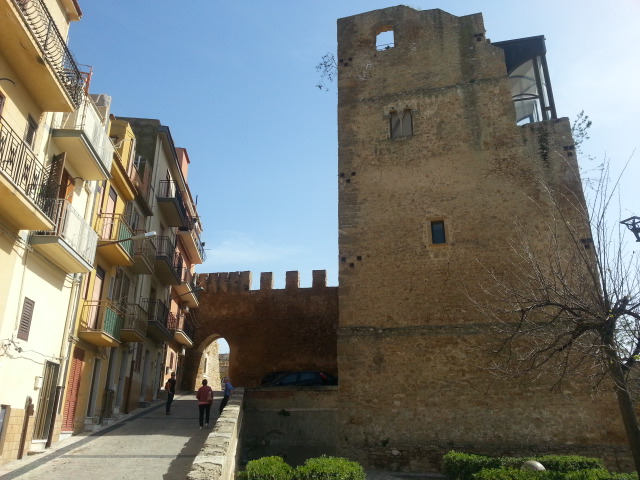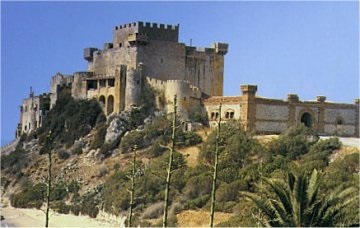Butera & castello di Falconara

Butera il Castello
Butera è stata per secoli l'obiettivo di conquista da parte di invasori de la Sicilia. La città esisteva già nel 854, quando l'emiro Alaba divenne Signore della contrada. Butera fu inizialmente fortificata e difesa da quattro o cinque giri. Questa roccaforte inespugnabile fu assediata per 26 anni da Norman Roger Guiscardo prima di conquistarla. I castelli di Butera e Falconara hanno una storia comune: entrambi sono stati concessi dal Re Martino I (1392) al suo fedele Ugone Santapau.
Butera était depuis des siècles l’objectif des conquêtes par les envahisseurs de la Sicile. La ville existait déjà en 854 lorsque l'émir Alaba est devenu seigneur de Butera. Elle était initialement fortifiée et défendu de quatre ou cinq tours. Ce bastion inexpugnable fut assiégé pendant 26 ans par le Normand Roger Guiscard avant de le conquérir. Les châteaux Butera et celui de Falconara ont une histoire commune: les deux ont été accordés par le Roi Martin Ier (1392) à son fidèles Ugone Santapau.
Butera had for centuries been the objective of conquests by the invaders of Sicily. The city already existed in 854 when the emir Alaba became lord of Butera. It was initially fortified and defended by four or five towers. This impregnable bastion was besieged for 26 years by the Norman Roger Guiscard before conquering it. The Butera and Falconara castles have a common history: both were granted by King Martin I (1392) to his faithful Ugone Santapau.
Butera était depuis des siècles l’objectif des conquêtes par les envahisseurs de la Sicile. La ville existait déjà en 854 lorsque l'émir Alaba est devenu seigneur de Butera. Elle était initialement fortifiée et défendu de quatre ou cinq tours. Ce bastion inexpugnable fut assiégé pendant 26 ans par le Normand Roger Guiscard avant de le conquérir. Les châteaux Butera et celui de Falconara ont une histoire commune: les deux ont été accordés par le Roi Martin Ier (1392) à son fidèles Ugone Santapau.
Butera had for centuries been the objective of conquests by the invaders of Sicily. The city already existed in 854 when the emir Alaba became lord of Butera. It was initially fortified and defended by four or five towers. This impregnable bastion was besieged for 26 years by the Norman Roger Guiscard before conquering it. The Butera and Falconara castles have a common history: both were granted by King Martin I (1392) to his faithful Ugone Santapau.
Castello di FALCONA

Butera Castello di Falconara
Il castello, che sorge a pochi metri dalla spiaggia, fu edificato in diverse epoche attorno al nucleo centrale rappresentato da una vecchia torre quadrata detta appunto 'della Falconara' perché inizialmente i proprietari la utilizzavano per l'allevamento del falcone da caccia, sport molto amato in periodo svevo-normanno. Il castello esisteva già nell’854, quando l’emiro Alaba divenne signore di Butera. Ampliato e rafforzato nel corso del tempo, il maniero mantenne comunque, la sua funzione di vigilanza contro le incursioni dei pirati che fino al XVIII secolo saccheggiavano le coste.
Le château, qui se trouve à quelques mètres de la plage, a été construit à des moments différents autour du noyau représenté par une ancienne tour carrée appelée précisément la Falconara. Ce nom proviendrait d'élevage de faucons de chasse, sport apprécié dans la période souabe-Norman. Le château existait déjà en 854, lorsque l'émir Alaba est devenu seigneur de Butera. Élargi et renforcé au fil du temps, le manoir a toujours maintenu son rôle de surveillance jusqu'au XVIIIe siècle contre les pirates qui pillaient la côte.
The castle, which is a few meters from the beach, was built at different times around the nucleus represented by an old square tower called precisely the Falconara. The name derives from the breeding of hunting falcons, a sport enjoyed in the Swabian-Norman period. The castle already existed in 854, when the emir Alaba became lord of Butera. Expanded and strengthened over time, the mansion has always maintained its monitoring role until the 18th century against the pirates who pillaged the coast.
Le château, qui se trouve à quelques mètres de la plage, a été construit à des moments différents autour du noyau représenté par une ancienne tour carrée appelée précisément la Falconara. Ce nom proviendrait d'élevage de faucons de chasse, sport apprécié dans la période souabe-Norman. Le château existait déjà en 854, lorsque l'émir Alaba est devenu seigneur de Butera. Élargi et renforcé au fil du temps, le manoir a toujours maintenu son rôle de surveillance jusqu'au XVIIIe siècle contre les pirates qui pillaient la côte.
The castle, which is a few meters from the beach, was built at different times around the nucleus represented by an old square tower called precisely the Falconara. The name derives from the breeding of hunting falcons, a sport enjoyed in the Swabian-Norman period. The castle already existed in 854, when the emir Alaba became lord of Butera. Expanded and strengthened over time, the mansion has always maintained its monitoring role until the 18th century against the pirates who pillaged the coast.
